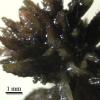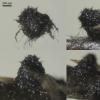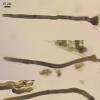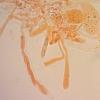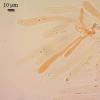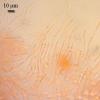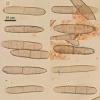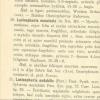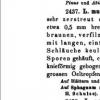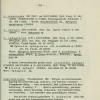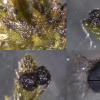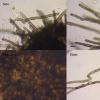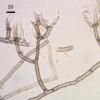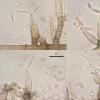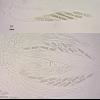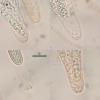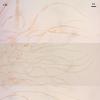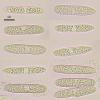
07-01-2026 22:22
 Danny Newman
Danny Newman
Tatraea sp. on indet. hardwood The Swag, Great Sm

07-01-2026 17:29
 Marc Detollenaere
Marc Detollenaere
Dear Forum,On a barkless Populus I found some smal

10-11-2021 17:33
 Riet van Oosten
Riet van Oosten
Add-on topic http://www.ascofrance.com/forum/7059

07-01-2026 10:24
 Danny Newman
Danny Newman
Pezicula sp. on indet. hardwood Appalachian Highl

07-01-2026 10:05
 Danny Newman
Danny Newman
cf. Chaetospermum on XylariaCosby Campground, Grea

02-01-2026 17:43
MARICEL PATINOHi there, although I couldn't see the fruitbody, I

04-01-2026 17:45
 Stephen Martin Mifsud
Stephen Martin Mifsud
I was happy to find these orange asmocyetes which
Perithecia globose to pyriform, to 700 mk high, 500-600 mk broad, site among dense weft of brown hyphae on sphagnum branches; dark brown, almost black, upper part setose, base with abundant hyphae, walls firm; all plant (sphagnum) becoming black and firm to the touch. Asci cylindrical, to 200 long, 15-20 broad; paraphyses cylindrical, segmented, 2-3 broad; spores cylindrical, becoming brown in asci, with 1-3 septa, gututlate, 36 (31-41) x 7 (5,5-8,8) (N=20).
Covering densely sphagnum in one spot; S. balticum probably, in wet bog hollow.

Best
Martin
L. sphagni DELACROIX, Bull. Soc. Mycol. France 6: 182
(1890). -
Wirt: Sphagnum sp.
L. sphagnorum (CR.) SACCARDO, Syll. Fung. 2:201 (1883).
MOUTON, Bull.Soc. Roy. Bot. Belgique 25: 157 (1886).
SVRCEK, Ceska Mykol. 25: 56 (1971). = Sphaeria sphagnorum CR. in CROUAN & CROUAN,
Fl. Finist.
24 (1867).
Wirte: Sphagnum nemoreum SCOP. (sub S. acutifolium), S. subsecundum
NEES. S. teres (SCHIMP. ) ÄNGSTR. , Sphagnum sp.
Alain
Now Andrew Miller reported me and he would be interesting in work with this specimen professionally, and i will send it to him. I will inform there about the results, as soon as they appear.
have you got the determination yet?
I have found this species for years on Sphagnum in wet, guite shadowed places and am very interested to know, what its is. This is not rare.
When you find it once, you will find it there every summer, if nothing dramatic happens in the surroundings.
Marja
Although it has been many years since this was observed, I am interested in whether you were able to confirm this collection as L. muscicola.
To me, the lack of obvious bending in the spores seems to eliminate Hilberina (L.) sphagni and H. sphagnorum, but there is some uncertainty in the literature about the differences between H. sphagnorum and L. muscicola (Svre?k, 1971).
I have recently examined very similar material on Scorpidium, also in bog habitat, which also seems to correspond with L. muscicola.
Interesting that such distinctive species have so few documented observations on the internet that I can see...
All the best,
George



